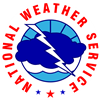Overview
On October 7th, upper troughing was located from the Hudson Bay south to the TN Valley. At the surface, an elongated area of low pressure and an associated cold front stretched from New England southwest to the Tennessee Valley/Deep South. During the next couple of days, the area of low pressure crossed the Mid-Atlantic/Southeast US before moving offshore by the morning of October 9th. At the same time (8 AM 10/7), a weak subtropical low was slowly moving northward off the Carolina coast. By the morning of October 9th, the subtropical low had started to merge with the frontal system as an upper low started to form just off the New Jersey coast. The two systems formed into one, potent area of low pressure that stalled off the NJ coast as strong (~1036 mb) high pressure became centered from Quebec to New Brunswick from 10/10-10/11.
After the front crossed the area during the morning hours of 10/8, winds switched to the NNE with sustained winds of 25 knots over the waters. While winds diminished slightly by 10/9-10/10, they still remained around 20 knots (sustained) over the waters. These persistent N-NE winds (along with high waves/seas) allowed water levels to slowly rise throughout the bay, ocean, and tidal rivers from 10/8 to 10/11. Widespread minor tidal flooding was observed by late on the 10th before water levels reached moderate flood thresholds in most areas on the bay (with minor flooding on the ocean) by the afternoon of the 11th. Winds rapidly diminished by the evening of the 11th, but tidal anomalies continued to increase over the upper Chesapeake Bay by the morning of the 12th. This caused water levels to exceed major flood thresholds from the VA Northern Neck to the Dorchester County, MD during both high tide cycles on 10/12. Widespread moderate flooding was observed across the middle/lower Chesapeake Bay, York River, and upper James River. Water levels peaked just below moderate flood thresholds across the Lower James River, southern shore of the Chesapeake Bay, and the Atlantic coast. Water levels receded from 10/13-14.
Despite the fact that the main area of low pressure remained a few hundred miles offshore, water levels at Lewisetta, Cambridge, and Bishop's Head were the highest observed in several years (in many cases, top 5 all-time). See the Coastal Flooding section for more details as well as Hydrographs from the event.
Flooding
Hydrographs
 |
 |
 |
 |
| Cambridge, MD (Dorchester County) | Bishop's Head, MD (Dorchester County) | Lewisetta, VA (Northumberland County) | Crisfield, MD (Somerset County) |
 |
 |
 |
 |
| Windmill Point, VA (Lancaster County) | Bayford, VA (Northampton County) | Saxis, VA (Accomack County) | Yorktown, VA (York County) |
 |
 |
 |
 |
| Kiptopeke, VA (Northampton County) | Sewell's Point, VA (Lower James River) | Jamestown, VA (James City County) | Chesapeake Bay Bridge Tunnel |
Photos
Tidal Flooding Photos
 |
 |
 |
 |
| Taylor's Island, MD (source: Dorchester County Emergency Management) |
Oakley Street-Cambridge, MD (source: Dorchester County Emergency Management) |
Willis Street-Cambridge, MD (source: Dorchester County Emergency Management) |
Edge of Coastal Flooding during High Tide-Cambridge, MD (source: Dorchester County Emergency Management) |
Environment
Upper Level Synoptic Summary.
 |
 |
 |
 |
| 10/7 8 AM 500 mb Analysis | 10/9 8 AM 500 mb Analysis | 10/10 8 AM 500 mb Analysis | 10/11 8 AM 500 mb Analysis |
Synoptic Surface Analysis.
 |
 |
 |
 |
| 10/7 8 AM WPC Surface Analysis | 10/9 8 AM WPC Surface Analysis | 10/10 8 AM WPC Surface Analysis | 10/11 8 AM WPC Surface Analysis |
 |
Media use of NWS Web News Stories is encouraged! Please acknowledge the NWS as the source of any news information accessed from this site. |
 |